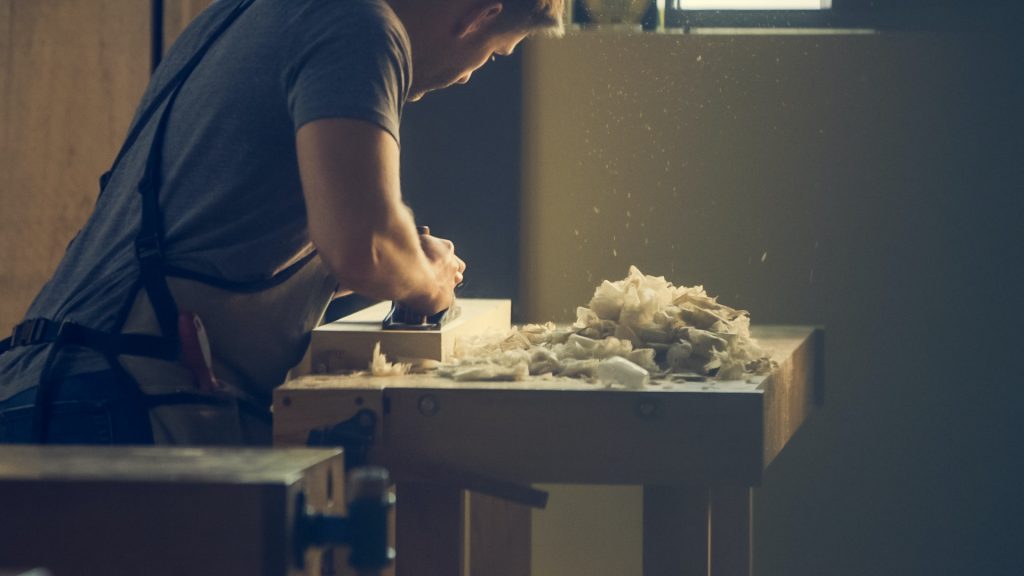Featuring On a Hill & Co.

Hello, I’m the Trusty Business and welcome to my office here in Charlotte, North Carolina. I work at Invenst Labs, and we’re here to ignite impact in your organization through Operational Innovation and Impact Marketing. We’re going to show you how to innovate your Carpentry business model for success to set yourself apart and differentiate yourself from the business competition – so stay tuned and enjoy this episode.
Today we’re gonna be talking about a Carpentry business, and I wanted to show everyone how to use the LAMB model on a Carpentry business to differentiate the company from the rest of the competition.
When I worked with this client, they submitted the information back in March 2019 and within just a day, I was able to innovate their model, slightly. But over the next few months getting to know the client, I understood that they actually had a huge value proposition that they were, kind of, holding onto. And it took a little bit of time to extract that information from the client.
So I’m gonna walk you through the two-step process of how I went from one model of innovation to another. So let’s start with the answers that the client gave us initially.
Step 1
So here I asked them to identify the problem. The problem that they identified here is that their “customers” have.
For example, they say:
- That people don’t have exactly what they want.
- People don’t have the time to build what they want
- There’s not a lot of skilled custom workers in their area – their area is North Orlando.
Contractors cannot be trusted and are limited to home improvement, not home decor. Let me remind you that this is not the opinion of the client that I am working with, but this is the presupposition or guess that their customers are having these issues.
So, now let’s take a look at their customers.
- They are busy people between 30 and 60 years old.
- They have above-average income: I would say average income above $40,000. They are probably looking between $40 and $60,000.
- And then there are women who love to use Pinterest and Facebook. So these are “okay” demographics, but I would like to extract a little bit more information on that.
So let’s look at the solutions.
So in order to solve for busy people, 30 and 60 years old, who can’t buy exactly what they want, they are selling them custom furniture.
For people that don’t have the time and skill to build what they want, they are selling them custom furniture and they’re doing personal consultations and updates along with building the process to make sure that the customer needs are met.
These are all kinds of one-on-one problem solutions for each customer. and the first few sections of this document from 1 through 5 are really identifying product-market fit, and I’ll speak about this in my number of different videos. But what we are looking for is that we’re trying to see that product and service offering to customers is actually delivering value to solve the problem.
So let’s take a look at their competitors.
Their competitors are general contractors, they are saying, overly priced, licensed and insured.
When I asked them who else is a competition, they replied with “maybe some construction or loan lumberyard that are kind of monopolizing the area”. And as you can see here, they left the unfair advantage blank. So my first recommendation for them was to think like “what do you think is your unfair advantage?” and “why should I choose you over the competition?”
They gave us some answers, so I am just gonna put these answers in here which was that:
- They follow best practices
- They are honest and knowledgeable
- They are relational
- They have a personalized touch
- They were looking at doing some Christian counseling.
The owner of the company is really adept at Christian knowledge and biblical knowledge, so we want to maybe include some sort of unfair advantage there.
As far as the other qualities go that they are saying is their unfair advantage, it’s not very different from what other people say, so I would want to, you know, really try to drive home what their unfair advantage is by having it be something that’s completely unique. I realized that they didn’t have a fine-tuned product-market fit, so I wanted to go back in here and figure out who are their customers, and what is the problem that we are trying to solve for each one of them, and how we are solving it specifically?
Step 2
So I actually went through and interviewed this client and we found out that the people that can’t buy what they exactly want are purchasing those things from traditional box stores.
So for “not a lot of skilled custom workers are found in my area”, we find that a little bit more closely to “their” area so people don’t have access to skilled and top-rated corporate carpenters in the Deltona area.
Then for “Contractors that can’t be trusted”, we removed that as it’s not necessarily a problem that we have identified in their customer base.
For “people don’t have the time or skill”, we actually replace that with “people can’t customize their dining tables to their home”. They are forced to buy what is already available so I want you to focus here on dining tables. Why are we talking about the dining table specifically? Well, we are talking about dining tables because they are a new unfair advantage. As I interviewed him, they actually really want to specialize in custom dining tables, and that was a new piece of information that I got from the client after interviewing him for a while.
If you are working on this for your own company, you want to be really diving in deep, grabbing a fresh piece of paper and just writing down these ideas, and after you feel like you have exercised all of your ideas, start with a new piece of paper and try again because there is something to be said about the brain and the capacity to come up with more ideas when you force it into a situation where you have to do that. So if this is your own company, you want to spend a lot of time building your own business model.
Alright moving on, we wanted to narrow down the customer segments, so we have “busy people 30 to 60 years old” and now we are going to change that to “business professionals with sufficient expendable income”.
For “women who love Pinterest and Facebook”, we are changing that to “women in an average to above-average household” and then we are removing the “average income above 40000”.
Then we are also looking because of the market they are in, we’re looking at seniors and others with the taste for art decor so the solutions have changed a little bit. Instead of “custom furniture/blanket furniture” we’re actually now doing “custom dining table” and instead of “reasonable prices” (we never want to compete on price), we are doing “accent pieces” and then instead of “personal consultation and update along with the process”, we are doing “custom art carpentry”.
So now, without looking at the competitors this time, we are beginning to see a very unique business model to this carpenter. He’s specializing in dining tables, and they are customizing accent pieces around the dining table. So let me dive a little bit more into that with their new unfair advantage. Their new unfair advantage is “We design unique dining tables to match the space and breathe life into your home. We consider the dining table the foundational piece of art in your home, and therefore, we design all other places around this.”
So now we have a unique business model with great product-market fit because if somebody needs a dining table for the home, this guy will go into the house, he will map the space, he will design the dining table with complimentary wood, complimentary stains and complimentary size to the space you have, and then he’ll recommend different upsells and cross-sales based on the decor that you have around your house. That could be anything from a cutting board to the rolling pin in your kitchen to the front home address sign that is outside your house or a shelf. Everything is connected to your home but also tying into the design and the feel of the dining table. So in this instance, we have differentiated his business from all other carpentry businesses in the area because nobody is doing this.
Now I would like to showcase all of our customers after the LAMB model so here is the On a Hill & Company – woodworking furniture and home decor website if you want to check it out. Here they do custom dining tables, they do ship nationwide, and they do custom woodworking. You can also see some of their latest creations. This guy is a master at carpentry. I definitely recommend checking them out.
We want to share this Lean Agile Model for Business with the whole world teaching people how to innovate their business model and differentiate themselves from the competition. Please leave your ideas in the comments below. We would like to know which business models you want us to feature next or submit your own at lamb.invenst.com, and we’ll maybe feature you guys on future posts.
You can also visit our store and learn more about our products and services.
Thank you so much for joining me, and I hope you’ll catch me next time.

